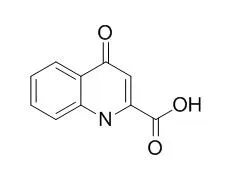| Description: |
Kynurenic acid, a natural metabolite of tryptophan via the kynurenine pathway, is a broad-spectrum excitatory amino acid antagonist; It proved to be an antagonist at NMDA, kainate and AMPA receptors.Kynurenic acid is the endogenous α7 nicotinic acetylcholine receptor antagonist, it has an immunomodulating effect, it can modulate amyloid-β-induced inflammation in BV-2 microglial cells. |
| In vivo: |
| J Neural Transm. 2014 Jul;121(7):725-38. | | Pre-treatment with new kynurenic acid amide dose-dependently prevents the nitroglycerine-induced neuronal activation and sensitization in cervical part of trigemino-cervical complex.[Pubmed: 24385076] | The systemic administration of nitroglycerine induces attacks in migraineurs and is able to activate and sensitize the trigeminal system in animals involving glutamate and α7-nicotinic acetylcholine receptors, among others. Kynurenic acid is one of the endogenous glutamate receptor antagonists, and exerts inhibitory action on the α7-nicotinic acetylcholine receptors. Since Kynurenic acid penetrates the blood-brain barrier poorly, therefore a newly synthesized Kynurenic acid amide, N-(2-N-pyrrolidinylethyl)-4-oxo-1H-quinoline-2-carboxamide hydrochloride (KYNAa) was used with such a side-chain substitution to facilitate brain penetration in our study.
METHODS AND RESULTS:
We evaluated its modulatory effect on Kynurenic acid concentration in the cervical part of trigemino-cervical complex (C1-C2) and in the model of nitroglycerine-induced trigeminal activation using male Sprague-Dawley rats. One hour after 1 mmol/kg bodyweight KYNAa administration, the Kynurenic acid level increased significantly in C1-C2, which returned to the basal level at 300 min measured by high-performance liquid chromatography. KYNAa pre-treatment had dose-dependent, mitigating action on nitroglycerine-induced decrease in calcitonin gene-related peptide and increase in c-Fos, neuronal nitric oxide synthase and calmodulin-dependent protein kinase II alpha expression in the C1-C2. KYNAa also mitigated the behavioural changes after nitroglycerine. Thus, in this model KYNAa is able to modulate in a dose-dependent manner the changes in neurochemical markers of activation and sensitization of the trigeminal system directly and indirectly--via forming Kynurenic acid, possibly acting on peripheral and central glutamate or α7-nicotinic acetylcholine receptors.
CONCLUSIONS:
These results suggest that application of Kynurenic acid derivatives could be a useful therapeutic strategy in migraine headache in the future with a different mechanism of action. | | Schizophr Res. 2013 Nov;150(2-3):392-7. | | The effect of transient increases in kynurenic acid and quinolinic acid levels early in life on behavior in adulthood: Implications for schizophrenia.[Pubmed: 24091034 ] | Kynurenic acid is a tryptophan metabolite that is synthesized and released in the brain by astrocytes and acts as an antagonist of nicotinic acetylcholine receptors and N-methyl-d-aspartate glutamate receptors, both of which are critically involved in cognition as well as neural plasticity and brain development. The concentration of Kynurenic acid is increased in the brains of persons with schizophrenia and this increase has been implicated in the cognitive and social impairments associated with the disease. In addition, growing evidence suggests that the increase in Kynurenic acid may begin early in life. For example, exposure to influenza A virus during development results in a transient increase in Kynurenic acid concentration that could disrupt normal brain development and lead to cognitive deficits later in life. Changes in Kynurenic acid may thus provide a link between developmental exposure to viruses and the increased risk of subsequently developing schizophrenia.
METHODS AND RESULTS:
To test this, we mimicked the effects of influenza A exposure by treating rats with kynurenine, the precursor of Kynurenic acid, on postnatal days 7-10. We observed a transient increase in both Kynurenic acid and quinolinic acid during treatment. When rats were subsequently behaviorally tested as adults, those previously treated with kynurenine exhibited decreased social behavior and locomotor activity. In contrast, attentional function and fear conditioning were not affected.
CONCLUSIONS:
Together with other recent findings, these data have several implications for understanding how viral-induced changes in tryptophan metabolism during development may contribute to schizophrenia-related symptoms later in life. |
|






 Cell. 2018 Jan 11;172(1-2):249-261.e12. doi: 10.1016/j.cell.2017.12.019.IF=36.216(2019)
Cell. 2018 Jan 11;172(1-2):249-261.e12. doi: 10.1016/j.cell.2017.12.019.IF=36.216(2019) Cell Metab. 2020 Mar 3;31(3):534-548.e5. doi: 10.1016/j.cmet.2020.01.002.IF=22.415(2019)
Cell Metab. 2020 Mar 3;31(3):534-548.e5. doi: 10.1016/j.cmet.2020.01.002.IF=22.415(2019) Mol Cell. 2017 Nov 16;68(4):673-685.e6. doi: 10.1016/j.molcel.2017.10.022.IF=14.548(2019)
Mol Cell. 2017 Nov 16;68(4):673-685.e6. doi: 10.1016/j.molcel.2017.10.022.IF=14.548(2019)